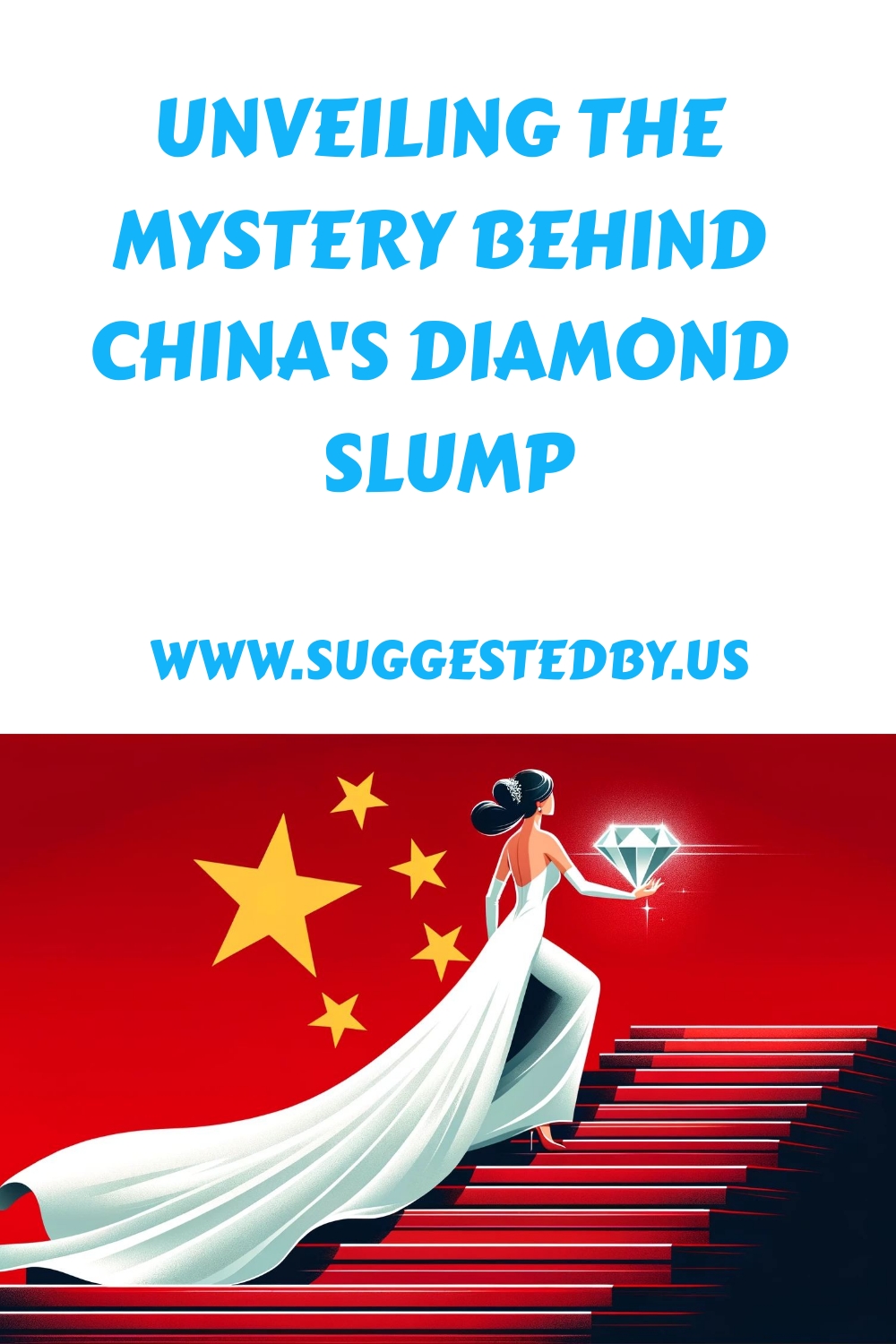Article Contents
- 1 Quick Answer
- 2 Introduction: Real Estate Crisis and Diamond Market Impact
- 3 Consumer Confidence and Economic Factors
- 4 The Rise of Gold and Decline of Diamonds
- 5 Changing Trends in Consumer Behavior
- 6 China’s Diamond Slump: What Does the Future Hold?
- 7 Frequently Asked Questions
- 8 Further Reading About China’s Diamond Slump
Quick Answer
China’s diamond market has suffered due to the country’s real estate crisis and overall economic downturn, leading to a drop in consumer confidence. Consumers are shifting away from diamonds, preferring more stable investments like gold, which has led to a major impact on the diamond industry.
Discover the underlying causes behind China’s diamond slump amidst a general market downturn and the ripple effects of the real estate crisis. Explore how shifting consumer preferences and economic uncertainties reshape the diamond industry landscape.
Introduction: Real Estate Crisis and Diamond Market Impact
China’s real estate crisis has profoundly impacted various sectors, including the diamond market. The correlation between the real estate downturn and consumer spending habits has become increasingly evident as the country grapples with economic challenges.
- Exploring the Real Estate Crisis: In mid-2023, amidst the lingering real estate crisis in China, property firms resorted to offering unconventional incentives like gold bars to stimulate apartment sales. The perception that gold holds its value better than real estate prompted these tactics, but the outcome fell short of expectations. The demand remained subdued despite efforts to entice buyers with additional benefits such as cars, cell phones, and free decorations.
- Impact on Consumer Confidence: The real estate slump and other factors, such as trade tensions and the pandemic, have significantly affected consumer confidence. The downturn in real estate and stock markets has led individuals to reassess their spending patterns, causing a ripple effect across various industries, including diamonds.
“People put a lot of money in real estate, and some in stocks, so when you see the downturn at such a high level, it has a major impact,” noted Abhishek (Andy) Golecha, the general manager of KGK Shanghai.
Amidst discussions at the Presidents’ Meeting of the World Federation of Diamond Bourses, held in Shanghai, participants acknowledged the challenges posed by the economic landscape. The panel highlighted the nuanced relationship between economic downturns, consumer behaviour, and the evolving dynamics of the diamond market.
The prevailing cautious sentiment among consumers, exacerbated by uncertainties surrounding the pandemic and prolonged economic instability, has reshaped spending preferences. As households prioritize savings and navigate the market’s uncertainties, their reluctance to invest in assets perceived as depreciating, such as diamonds, has become more pronounced.
While diamonds have experienced a decline in demand, the resilience of gold as an investment choice has come to the forefront. Jewellers have adapted to this shift by emphasizing the appeal and value of gold jewellery, leveraging storytelling and cultural influences to drive sales.
As China’s consumer market continues to evolve, with preferences shifting towards value-oriented and ethically sourced products, the diamond industry must adapt to changing consumer behaviours and expectations. To thrive in this dynamic landscape, a commitment to ethical practices and a keen focus on consumer needs are essential.
Consumer Confidence and Economic Factors
The ongoing challenges faced by China’s real estate sector have had a ripple effect on consumer behaviour, particularly in the diamond market. Amid the real estate crisis, property firms in mid-2023 resorted to offering gold bars to incentivise apartment purchases. The idea that gold holds its value better than real estate caused this shift. Despite these efforts, the response from consumers remained subdued as the property market continued to struggle.
One of the key takeaways from the Presidents’ Meeting of the World Federation of Diamond Bourses in Shanghai was the significant impact of the property downturn on consumer confidence and the overall diamond market. Abhishek (Andy) Golecha, general manager of KGK Shanghai, highlighted that the high levels of investment in real estate and stocks, coupled with the downturn, have profoundly influenced consumer sentiment.
Alongside the challenges in the real-estate sector, trade tensions with the United States and the lingering effects of the pandemic have further compounded consumer spending patterns. The economic pressures exacerbated by COVID-19 and the extended lockdowns in China have instilled a sense of financial caution among households. With limited incomes and uncertainties about the future, households have shown a reluctance to engage in discretionary spending.
Professor Zhang Jun, the dean of the School of Economics at Fudan University, emphasized the prevailing cautious sentiment among Chinese consumers due to the economic uncertainties. The reluctance to spend freely is reflected in the country’s high propensity for saving, which focuses on preparing for future financial challenges in areas such as education, healthcare, and housing.
Notably, the shift towards caution in consumer behaviour is also evident in the choices regarding asset purchases. When faced with a stagnant economy, Chinese consumers tend to avoid investing in assets in a declining market. This hesitance has extended to the diamond market, where the perceived price decrease deters consumers.
Lawrence Ma, the founding president of the Diamond Federation of Hong Kong, China, pointed out that the challenge for the diamond industry lies in convincing consumers about the enduring value of diamonds amidst price fluctuations. On the contrary, there has been a surge in demand for gold products, particularly 24-karat gold, which consumers view as a stable investment option.
The resurgence of gold jewellery, especially among younger consumers, can be attributed to effective marketing strategies that leverage social media and cultural narratives. Technological advancements that have improved the design and appeal of gold products have further fueled this shift in consumer preferences toward gold jewellery.
As a result of the changing consumer landscape, jewellers have witnessed a notable increase in gold jewellery sales, compensating for the weakness in diamond sales. Companies like Chow Sang Sang reported a significant growth in gold jewellery sales, offsetting the decline in diamond jewellery purchases.
While the diamond market faces challenges in 2024, industry players must adapt to evolving consumer preferences. The emphasis on sustainability, ethical sourcing, and personalized experiences underscores the changing dynamics of the consumer market in China. To thrive in this competitive landscape, stakeholders must remain agile, commit to ethical practices, and align their strategies with consumer demands.
As the diamond trade grapples with shifting consumer behaviour and market dynamics, the key lies in fostering consumer confidence and enhancing the desirability of diamond jewellery. By addressing consumer concerns, leveraging storytelling techniques, and emphasizing the unique value proposition of natural diamonds, industry players can navigate through uncertainties and capture the evolving preferences of the Chinese market.
The Rise of Gold and Decline of Diamonds
In mid-2023, as China grappled with a real-estate crisis and property firms sought ways to boost sales, an interesting trend emerged—offering gold bars as an incentive to potential apartment buyers. The rationale behind this move was the perception that gold maintains its value amidst market fluctuations, unlike real estate investments. Despite additional offerings such as new cars, cell phones, decorations, and parking lots, the impact on sales remained minimal as supply exceeded demand.
The ongoing real estate downturn has significantly affected consumer confidence and the diamond market in China. At a meeting of the World Federation of Diamond Bourses in Shanghai, industry participants discussed the challenges faced by the diamond market amidst the prevailing economic conditions.
The Impact of Economic Factors
Various factors, including the property crisis, trade tensions with the US, and the lingering effects of the pandemic, have collectively influenced consumer behaviour and spending patterns in China. The aftermath of COVID-19, coupled with China’s cautious approach to economic recovery, has resulted in limited household income and a prevailing sentiment of uncertainty among consumers.
Due to the economic slowdown and prevailing market conditions, Chinese consumers are reluctant to invest in depreciating assets. This attitude has also affected the diamond industry, with consumers hesitating to purchase due to perceived price declines.
Preference for Gold Over Diamonds
Conversely, there has been a resurgence in the demand for gold products, particularly 24-karat gold, among Chinese consumers. The shift in consumer preferences towards gold jewellery can be attributed to various factors, including cultural influences, marketing strategies, and product innovation.
Younger consumers, who previously overlooked gold jewellery as a more traditional choice, have now embraced it thanks to evolving marketing tactics and incorporating Chinese cultural elements in jewellery designs. Advancements in technology have also enhanced the appeal of gold jewellery by offering more intricate designs and vibrant colour options.
Market Trends and Sales Performance
Jewellers have capitalised on the growing popularity of gold jewellery, leveraging the trend to offset the weakening demand for diamond products. Retailers like Chow Sang Sang reported notable increases in same-store sales driven by gold jewellery, compensating for the decline in diamond sales.
As consumer preferences evolve and economic uncertainties persist, the diamond market in China faces considerable challenges. Factors such as misinformation, the emergence of lab-grown diamonds, and changing marriage trends have contributed to the decline in diamond sales and a shift towards alternative investment choices.
Amidst these shifting market dynamics, industry experts emphasize the need for the diamond trade to adapt and enhance the appeal of natural diamonds to consumers. By understanding evolving consumer preferences, embracing ethical practices, and focusing on product desirability, the diamond industry can navigate the changing landscape and secure its relevance in the Chinese market.
Changing Trends in Consumer Behavior
Cultural shifts and technological advancements constantly shape the market landscape. These changes have significantly altered consumer behaviour in recent years, particularly in the diamond industry.
One key factor impacting consumer decisions is the evolving cultural landscape. As traditions change and societal norms shift, consumers reevaluate their preferences and priorities when purchasing. This shift is influenced by external cultural elements and internal values and beliefs that drive consumer choices.
Moreover, technological advancements have revolutionized how consumers interact with products and brands. The digital age has provided consumers unprecedented access to information, enabling them to make more informed purchase decisions. E-commerce platforms, social media, and online reviews have all contributed to this shift in consumer behaviour.
Another crucial aspect that has gained momentum in recent years is the impact of sustainability and ethical sourcing on diamond purchases. Consumers are becoming increasingly conscious of their buying decisions’ environmental and ethical implications, leading to a growing demand for ethically sourced and sustainably produced products, including diamonds.
Diamond industry companies recognise the importance of aligning with these consumer values. By adopting sustainable practices and ensuring the ethical sourcing of diamonds, businesses are meeting consumer expectations and contributing to a more responsible and transparent industry.
- Exploring the influence of cultural shifts and technological advancements on consumer choices
- Analyzing the impact of sustainability and ethical sourcing on diamond purchases
As the consumer landscape evolves, businesses must adapt to these changing trends to remain relevant and competitive in the market. Understanding the influence of cultural shifts, technological advancements, sustainability, and ethical sourcing is essential for companies looking to meet the evolving demands of today’s consumers.
China’s Diamond Slump: What Does the Future Hold?
As China’s diamond market faces challenges amidst changing trends, industry experts are closely monitoring the trajectory of this vital sector. With various factors influencing consumer behaviour and market dynamics, strategic adaptations are essential for the diamond industry’s sustained success.
One significant factor impacting China’s diamond market is the country’s real-estate crisis, which has shifted consumer preferences towards alternative investments like gold. Trade tensions and the lingering effects of the pandemic have exacerbated the property slump and decreased demand for diamonds.
Furthermore, Chinese consumers are cautious about spending in the current economic climate. The preference for assets with perceived stability, such as gold, has seen a surge in demand for gold jewellery among younger demographics. In contrast, the diamond industry is experiencing a decline in sales, attributed to consumers’ perceptions of decreasing diamond prices and the emergence of lab-grown diamonds.
Despite these challenges, the diamond industry has opportunities to revitalize its market presence. By understanding evolving consumer behaviours and preferences, industry players can leverage storytelling, cultural influences, and innovation to enhance the appeal of diamond jewellery. Emphasizing ethical practices, sustainability, and personalized experiences can resonate with the discerning Chinese consumer base.
Staying agile and responsive to market demands is crucial for the diamond industry’s future growth in the face of a maturing market and shifting consumer values. By fostering consumer trust, promoting natural diamonds’ unique value proposition, and embracing digital marketing strategies, industry stakeholders can navigate the evolving landscape and secure a resilient position in China’s dynamic diamond market.
In summary, the future of China’s diamond market hinges on the industry’s ability to adapt to changing consumer preferences, emphasise ethical practices, and enhance the desirability of natural diamonds through innovation and storytelling.
Frequently Asked Questions
What is the Diamond Market Forecast for 2024?
The 2024 diamond market forecast predicts a decline due to falling prices, decreased consumer demand, increased competition from lab-grown diamonds, broader economic difficulties, and changes in consumer spending patterns.
Why are Diamond Prices Declining?
Diamond prices are declining due to a surplus of high-quality diamonds, decreased consumer demand, and economic uncertainties. Overstocked dealers, who purchased at higher prices, face challenges in a potentially tumultuous 2024 market.
What Is Going on in the Diamond Market?
The diamond market in 2024 is experiencing significant challenges due to reduced consumer demand, the popularity of lab-grown alternatives, and economic impacts such as the real estate crisis, affecting overall market stability and consumer spending.
Further Reading About China’s Diamond Slump
1: Stats on investing in diamonds, market trends and investment analysis
2: Why China’s diamond market is in dire straits
3: What to expect in the diamond market in 2024
4: How China’s new generation redefines luxury
5: The diamond crisis: China’s market in 2024






